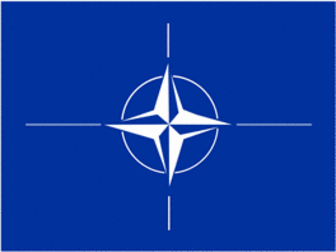
The main design for the NATO Flag symbol was approved by the North Atlantic Council on October 14, 1953. The exact origins of the NATO emblem are unclear, although it is known that the basic design was conceived by a member of the International Staff. The flag has a navy blue (Pantone #280) field charged with a white compass rose emblem from which radiates four white lines. The outlines that extend from the star of the NATO flag may vary in length.
The search for a NATO emblem started nearly three years after the birth of NATO. The birth of the NATO emblem and its incorporation into a flag involved many design proposals. The goal was to have an emblem that symbolized the principles of the North Atlantic community. In August 1952, the matter was referred to the newly created NATO Information Policy Working Group. After several exchanges of views, the Working Group agreed to "recommend to the Council that there should be a NATO Flag", and an emblem within it. The Council agreed that finding a design acceptable to all of the member nations and reflected the values of the alliance was paramount. One of the many designs submitted was a silver shield with 14 stars and two blue stripes, the stars symbolizing the 14 then-members, the blue stripes representing the Atlantic Ocean. This design was rejected however, as the emblem would require alteration if and when future nations were added.
On October 28, 1953, NATO Secretary Lord Ismay announced that a design for the official emblem had been adopted. The symbolism of the emblem was described as "a four-pointed star representing the compass that keeps us on the right road, the path of peace, and a circle representing the unity that binds together the 14 countries of NATO." The blue background represented the Atlantic Ocean and the circle symbolized unity.